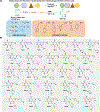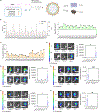Tetrahydropyrimidine Ionizable Lipids for Efficient mRNA Delivery
- PMID: 39393001
- PMCID: PMC11781979
- DOI: 10.1021/acsnano.4c10154
Tetrahydropyrimidine Ionizable Lipids for Efficient mRNA Delivery
Abstract
Lipid nanoparticles (LNPs) have emerged as an effective and promising technology for messenger RNA (mRNA) delivery, offering a potential solution to physiological barriers and providing an alternative approach to gene therapy without the drawbacks associated with viral delivery. However, efficiently delivering mRNA remains a significant challenge in nucleic acid-based therapies due to the limitations of current LNP platforms in achieving optimal endosomal escape and mRNA release, which largely relies on finding a suitable ionizable lipid. Additionally, the synthesis of these ionizable lipids involves multiple chemical reactions, often making the process time-consuming and difficult to translate. In this study, we employed a facile, catalyst-free, and versatile one-pot multicomponent reaction (MCR) to develop a library of ionizable lipids featuring a pharmacologically significant tetrahydropyrimidine (THP) backbone, tailored for enhanced mRNA delivery. A library of 26 THP ionizable lipids was systematically synthesized in just 3 h and formulated with luciferase mRNA for initial in vitro screening. The THP LNPs exhibited tunable particle sizes, favorable ζ-potentials, and high encapsulation efficiencies. Among them, THP1 demonstrated the highest transfection efficiency both in vitro and in vivo after intramuscular administration, comparable to DLin-MC3-DMA (MC3), a conventional benchmark. Further optimization of THP1 with phospholipids significantly enhanced intramuscular mRNA delivery and showed sustained protein expression in vivo for up to 5 days. More importantly, it demonstrated successful intravenous delivery in a dose-dependent manner with minimal toxicity, as indicated by hematological, histopathological, and proinflammatory cytokine assessments. Furthermore, THP1 LNPs also demonstrated the ability to edit genes in specific liver tissues in a tdTomato transgenic mouse model, highlighting their precision and utility in targeted therapeutic applications. These findings position THP1 LNPs as promising candidates for advancing mRNA-based therapies, with significant implications for clinical translation in vaccine delivery and CRISPR/Cas9-mediated gene editing in the liver.
Keywords: biomaterials; in vivo delivery; ionizable lipid; lipid nanoparticles; mRNA; multicomponent reaction; tetrahydropyrimidine.
Conflict of interest statement
The authors declare the following competing financial interest(s): I.I. and C.B. have filed a patent application based on this work.
Figures





References
-
- Qiu M; Li Y; Bloomer H; Xu Q Developing Biodegradable Lipid Nanoparticles for Intracellular mRNA Delivery and Genome Editing. Acc. Chem. Res. 2021, 54 (21), 4001–4011. - PubMed
-
- Olszewska M; Bujarski JJ; Kurpisz M P-Bodies and Their Functions during mRNA Cell Cycle: Mini-Review. Cell Biochem. Funct. 2012, 30 (3), 177–182. - PubMed
Publication types
MeSH terms
Substances
Grants and funding
LinkOut - more resources
Full Text Sources
Other Literature Sources

